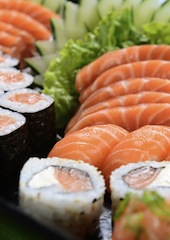Food and Foreign Policy: A Diplomatic Cuisine
What can food teach us about global conflicts and creative diplomacy?
March 2, 2014

Think about your kitchen—where meals are prepared and served – and where your guests end up congregating despite best efforts to put them in the living room.
You probably never thought of your kitchen as a foreign policy venue, but increasingly the kitchen, and more, specifically, food is becoming a “staple” of global diplomacy.
Food is more than sustenance. Next to breathing, it is the most basic of human needs. Mixed with culture and ethnicity, food is a powerful ingredient in human and foreign relations. It is how individuals and societies relate to one another.
The historic importance of food goes back to the time of the Greeks and Romans, when adversaries used food to negotiate, settle disputes and divulge state secrets over long meals with ample wine to loosen tongues.
But now, there is a new twist on the subject of food and foreign policy. For example, American University in Washington, D.C. is offering courses in culinary diplomacy and conflict cuisines, recognizing the growing importance of the food industry around the world.
The course we teach focuses on “conflict cuisines.” Even as these conflicts per se recede into historical memory, the conflicts of the Cold War were very influential in terms of creating a new culinary diaspora.
In the second half of the 20th century a much more diverse melting pot emerged.
It brought the foods of Southeast Asia, the Middle East, the Caribbean and the varied Central American diet to the United States, which until then mostly had a European culinary culture. These new ethnic cuisines differed from the standard Tex-Mex foods that had been part of our border culture.
Food diplomacy
Food diplomacy is growing with the mobility of international travelers. It is also coupled with the growing importance of diaspora communities where food is part of local culture.
In any larger American or European city, you see a snapshot of the world through the windows of ethnic restaurants from Ethiopian food to Nepali or Turkish delights.
Often, these eateries reflect cuisines born of conflicts, recipes that migrated with refugees and those seeking freedom from closed societies. This can occur when immigrants try their hand as restaurateurs, bringing their cuisines to a new community and gaining acceptance through the kitchen.
Through a country’s kitchen, one can garner a better sense of how food serves as a tool of soft power and communication – when language alone is not enough.
The United States, for example, may not have official relations with Cuba, but one can find Cuban cuisine in many parts of the United States beyond Miami. U.S.-Vietnamese diplomatic relations was formally re-opened only in July 1995, long after the proliferation of Vietnamese restaurants in America.
We Americans may not have a nuclear deal with Iran yet, but we can sample Iranian food. A simmering conflict in Colombia didn’t stop a delegation of Colombian chefs from coming to Washington, D.C. recently to talk—food and peace.
Food as a convener and divider
Food can also bring people together when times are tough. Despite the fact, for instance, that Egyptians are in the midst of a deep political conflict and relations with the United States are strained, still a U.S.-Egyptian culinary exchange program is in the works for later this spring.
Greece is now marketing itself, despite a sluggish economy, as a gastro destination. And Peru is branding itself through a Pisco Sour cocktail and the gastronomy of its world-class chefs that combine pre-Colombian ingredients fused with modern Latin American dishes.
Food, however, is not always a source of unity. It is often a point of division. Wars break out over resources like food and water and we can expect future conflicts over access to the Nile, the Yangtze and throughout the Middle East.
Food, when withheld, can become a weapon of war. Just look at the humanitarian tragedy ongoing in Syria.
There are many serious global issues surrounding food from poor agriculture, droughts and the effect of climate change to food insecurity, poverty, hunger, malnutrition and childhood obesity.
Food is also part of religious traditions. Rituals like “fasting” or “Ramadan” end up with a meal, a feast, a chance to redeem all sins by committing new culinary ones!
In the end, if we can use the power of food to motivate people to find common ground, it is worth bringing people to the table. As Franz Kafka once said, “So long as you have food in your mouth, you have solved all questions for the time being.”
Takeaways
You probably never thought of your kitchen as a foreign policy venue, but food is a “staple” of global diplomacy.
Food diplomacy reflects the growing importance of diaspora communities where food is part of local culture.
Food is not always a source of unity. It is often a point of division. Wars break out over resources like food.
Read previous

China Takes a Vacation
March 1, 2014

